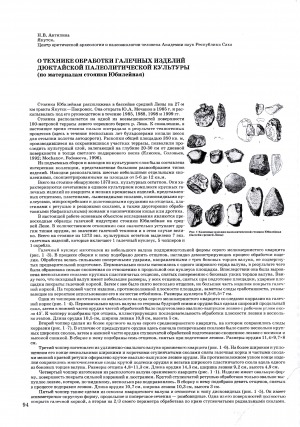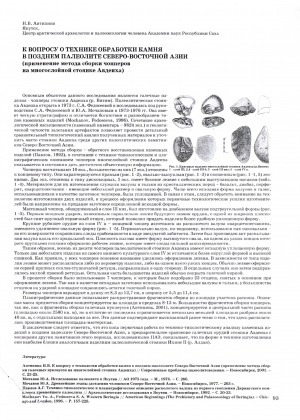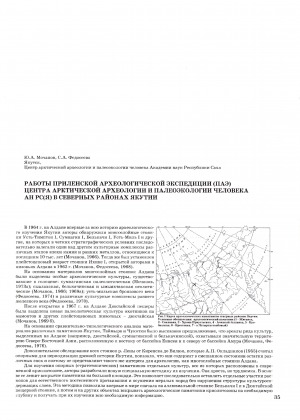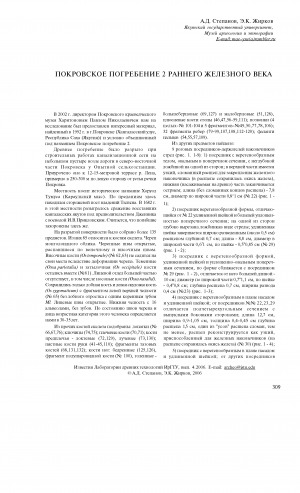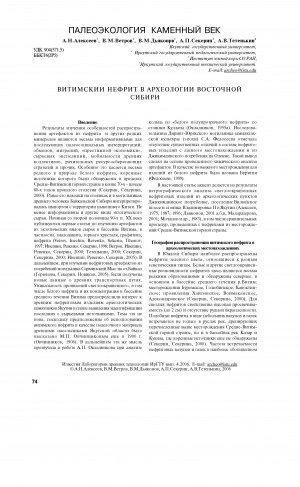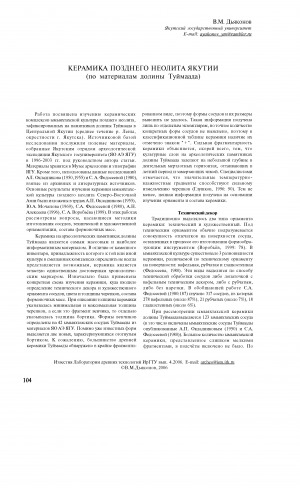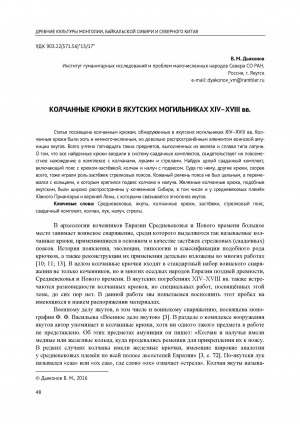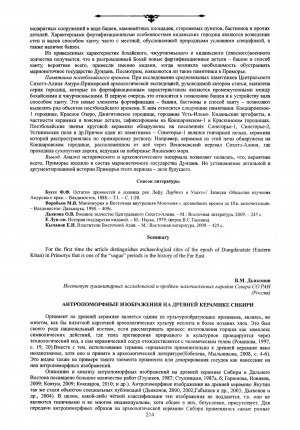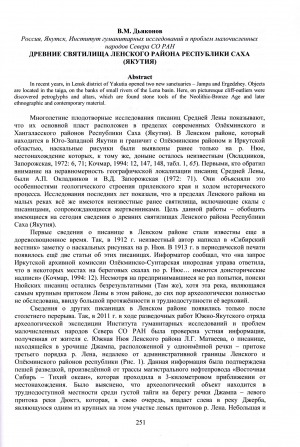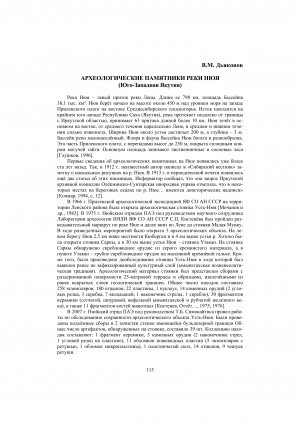- Книга (3532)
- Газета (3)
- Журнал (22)
- Автореферат диссертации (182)
- Изоиздание (11)
- Аудиоиздание (10)
- Видеоиздание (229)
- Картографическое издание (28)
- Неопубликованный документ (16)
- Нотное издание (1)
- Фотография (13)
- Статья (897)
- Библиографический указатель (237)
- Словарь (8)
- Календарь (4)
- Брошюра (76)
- Буклет (23)
- Игра (1)
- Веб-архив (276)
- Не указан (2)
- Литературно-художественные издания (354)
- Официальные издания (117)
- Научные издания (1512)
- Научно-популярные издания (2040)
- Информационные издания (727)
- Справочные издания (90)
- Учебные издания (136)
- Производственно-практические издания (3)
- Массово-политические издания (571)
- Изобразительное издание (17)
Количество страниц: 2 с.
Антипина, Н. В. О технике обработки галечных изделий Дюктайской палеолитической культуры : (по материалам стоянки Юбилейная) / Н. В. Антипина // Истоки, формирование и развитие Евразийской поликультурности. Культуры и общества Северной Азии в историческом прошлом и современности : материалы I(XLV) Российской с международным участием археологической и этнографической конференции студентов и молодых ученых (РАЭСК-XLV) 12-16 апреля 2005 г., Иркутск. — Иркутск: Радиан, 2005. — С. 94-95.
Количество страниц: 2 с.
Антипина, Н. В. К вопросу о технике обработки камня в позднем палеолите Северо-Восточной Азии : (применение метода сборки чопперов на многослойной стоянке Авдеиха) / Н. В. Антипина // Истоки, формирование и развитие Евразийской поликультурности. Культуры и общества Северной Азии в историческом прошлом и современности : материалы I(XLV) Российской с международным участием археологической и этнографической конференции студентов и молодых ученых (РАЭСК-XLV) 12-16 апреля 2005 г., Иркутск. — Иркутск: Радиан, 2005. — С. 93.
Количество страниц: 4 с.
Мочанов, Ю. А. Работы Приленской археологической экспедиции (ПАЭ) Центра арктической археологии и палеоэкологии человека АН РС (Я) в северных районах Якутии / Ю. А. Мочанов, С. А. Федосеева // Истоки, формирование и развитие Евразийской поликультурности. Культуры и общества Северной Азии в историческом прошлом и современности : материалы I(XLV) Российской с международным участием археологической и этнографической конференции студентов и молодых ученых (РАЭСК-XLV) 12-16 апреля 2005 г., Иркутск. — Иркутск: Радиан, 2005. — С. 35—38.
Количество страниц: 6 с.
Степанов, А. Д. Покровское погребение 2 раннего железного века / А. Д. Степанов, Э. К. Жирков // Известия лаборатории древних технологий. — 2006. — Вып. 4. — С. 309-313.
Количество страниц: 6 с.
This article presents the results of petrography research of light-colored nephritic artifacts from three archaeological sires of Yakutia (Dzhikimda's tomb. settlements Vladimirovka 2 and Viluickor shoosse). The results allow identifying with confidence these nephritic artifacts with deposit of light-colored nephritic on Middle Vitim. It was observed also some other manifestations of such artifacts of light-colored nephrite: on the west coast of Lake Baikal (west direction), on the Middle and Upper Vitim, in West Transbaikalia (south direction). Communications connected with the transporation the light-colored nephrite are recorded in the span of 8000-3500 BP. The longest distance of transportation is discovered namely in the case of Yakutia artifacts (about 1000 km in a bee-line). Authors appreciate this phenomenon of long communications as the specific of Neolithic of East Siberia.
Витимский нефрит в археологии Восточной Сибири / А. Н. Алексеев, В. М. Ветров, В. М. Дьяконов, А. П. Секерин, А. В. Тетенькин // Известия лаборатории древних технологий. — 2006. — Вып. 4. — С. 74-79.
Количество страниц: 15 с.
The article is devoted to research of the ceramic complexes of Ymyyakhtakh culture of Later Neolithic founded on the sites of Tuymaada valley in the central Yakutia (middle part of Lena river, neighborhood of Yakutsk). There were delineated two main traditions of ceramics technical decoration: waffle and ribbed ones. The smooth-sided vessels are rare. The consistence of the waffle Ymyyakhtakh vessels is really same to ribbed ones. In most cases the wool was an inevitable addition to the clay breed of Ymyyakhtakh pottery. Some waffle vessels are sharply different from others by the absence of sand in the clay breed. The most variations of receipts of the model mass belong to waffle pottery, but for every type of ceramic the main receipt is "clay + sand + debris + organics". The organic admixture is recorded in every Ymyyakhtakh vessel of Tuymaada. All discovered types (ribbed ceramics, waffle ceramics, smooth-sided ceramics) have complex profile of vessels. There couldn’t be delineating also any significant difference for artistic decoration.Generally, the artistic decoration of Ymyyakhtakh vessels of Tuymaada is analogous to ceramic complexes of the sites of Lena, Viluy, Aldan and Olekma rivers. But on Tuymaada there are discovered some new variants of decoration.
Дьяконов, В. М. Керамика позднего неолита Якутии : (по материалам долины Туймаада) / В. М. Дьяконов // Известия лаборатории древних технологий. — 2006. — Вып. 4. — С. 104-118.
Количество страниц: 9 с.
This article is dedicated to a quiver hooks found in Yakut burial grounds of XIV–XVIII centuries. Quiver hooks were though not abundant but quite a widespread element of the military ammunition of Yakuts. In total, we took stock of fifteen such items made of iron and brass-like alloy. The bases of the fourteen Yakut quiver hooks are plate-like and one hook is rod-like. The plates are either not structurally distinguished or look like a closed loop, sometimes bent to the side of the base, or a plate with a slot. The tonguelets of the iron hooks are a gradually tapering part of the base plate bent in a hooklike form to the front side. In one case the tonguelet is soldered to the base. We can assume that all the hooks were part of an archer's kit as in all places where we found them they were together with quivers, bows and arrows. We found a whole archer's kit comprising a belt with a hooklike buckle, a quiver and a case bow with a carrier strap, by which we can reckon that other hooks, most likely, served as the buckles of a shooter's belt. The leather belt is not one-piece but alternates with rings to which the carrying strap of the quiver and the bow case were attached. Iron quiver hooks, like Yakut ones, were widespread among nomads of Siberia including medieval tribes of the South Angara region and the Upper Lena region, with which the ethnogeny of the Yakuts is connected.
Дьяконов, В. М. Колчанные крюки в якутских могильниках XIV-XVIII вв.=Quiver hooks in Yakut burial grounds of XIV-XVIII centuries / В. М. Дьяконов // Древние культуры Монголии, Байкальской Сибири и Северного Китая : материалы VII международной научной конференции, Красноярск, 3-7 октября 2016 г. — Красноярск : Сибирский федеральный университет, 2016. — Т. 2. — С. 48-56.
Количество страниц: 9 с.
Work is devoted to the description and analysis of anthropomorphic images on ancient ceramics of Siberia. There were at least two large independent areas of generation and propagation of the tradition of making ceramic vessels with anthropomorphic images. This is a Transurals with Western Siberia, and East Siberia with Yakutia. Analysis of anthropomorphic images on ceramics shows the continuity of images and visual canons within the vast territories and over the millennia. The earliest examples of ceramics with anthropomorphic images belong to the Neolithic period and represented with bas-relief masks and full-growth figures. In the Paleometal and Middle Ages became typical stylized anthropomorphic figures and masks made in incised, stroke-ornamented, drag-and-jab or cogged-comb technique. Sculptural mask made in molded technology combined with grooves and impressions is a late relic of ancient traditions. Anthropomorphic images on ceramics were a sign of its singularity. They reflect the sacred, ritual or mythological beliefs of its creators.
Дьяконов, В. М. Антропоморфные изображения на древней керамике Сибири=Anthropomorphic images on ancient ceramics of Siberia / В. М. Дьяконов // Материалы V международной научной конференции "Древние культуры Монголии и Байкальской Сибири" (Кызыл, 15-19 сентября 2014 года). — Кызыл : Тувинский государственный университет, 2014. — Ч. 1. — С. 214-222.
Количество страниц: 5 с.
- Религия. Теология,
- Краеведение. Археология. География. Биографии. История > Историческая наука. Историография > Археология,
- Краеведение. Археология. География. Биографии. История > Историческая наука. Историография > История Якутии > Древняя Якутия,
- НАУКА ЯКУТИИ > РЕЛИГИЯ. ТЕОЛОГИЯ,
- НАУКА ЯКУТИИ > КРАЕВЕДЕНИЕ. ГЕОГРАФИЯ. БИОГРАФИИ. ИСТОРИЯ > Историческая наука. Историография,
- iYakutia > Древняя Якутия.
In recent years, in Lensk district of Yakutia opened two new sanctuaries - Jampa and Ergedzhey. Objects are located in the taiga, on the banks of small rivers of the Lena basin. Here, on picturesque cliff-outliers were discovered petroglyphs and altars, which are found stone tools of the Neolithic-Bronze Age and later ethnographic and contemporary material.
Дьяконов, В. М. Древние святилища Ленского района Республики Саха (Якутия) / В. М. Дьяконов // Интеграция археологических и этнографических исследований. — Иркутск : Иркутский государственный технический университет ; Омск : Омский филиал Института археологии и этнографии СО РАН, 2013. — Т. 2. — С. 251-255.
Количество страниц: 6 с.
Дьяконов, В. М. Археологические памятники реки Нюя (Юго-Западная Якутия) / В. М. Дьяконов // Человек и Север : антропология, археология, экология : материалы всероссийской конференции, г. Тюмень, 6-10 апреля 2015 г. — Тюмень : Издательство Института проблем освоения Севера СО РАН, 2015. — Вып. 3. — С. 115-120.
